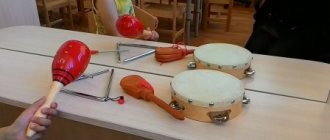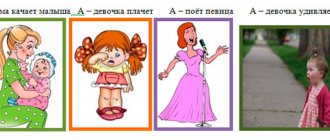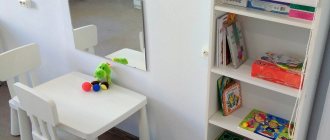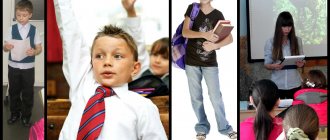LiveInternetLiveInternet
Then, as the pronunciation is corrected, the study of voiced consonants (B, D), velar (K, G, X) and sibilant sounds (S, 3, C) is added.
In this manual, when developing the skills of sound analysis and synthesis in the first year of study, the author suggests limiting the use of words with hissing and sonorant sounds (Ш, Ж, Ш, Ш, Л, Р), as well as soft variants of consonants to the second year year of study.
It is important that to create any sound analysis skill (for example, determining the final consonant), it is not enough to present the child with 3-5 words, as is often suggested in the manuals of other authors.
The author of this manual recommends using at least 10-20 words to develop each skill. Otherwise, the skill is difficult to both automate and control.
The presented book is intended for children with general speech underdevelopment. The volume of tasks that a speech therapist needs to perform when correcting this disorder is large. However, it is important for every specialist working with children in this category to remember that incomplete correction of general speech underdevelopment, that is, the persistence of even minor pronunciation defects, agrammatisms, disturbances in the syllabic structure of words, difficulties in sound analysis and synthesis, etc., by the beginning of schooling, can lead to to persistent, specific defects in writing and reading.
For reading children who have preserved (even in a mildly expressed form) general underdevelopment of speech, the following are characteristic:
– difficulties in merging sounds into syllables and words, mutual substitutions of phonetically or articulatory-close consonant sounds: whistling - hissing, hard - soft, voiced - deaf (helmet-kashka, help-help, chew-yawn), distortion of the syllabic structure of words (corrected instead of crossed, operation instead of operating room, took out instead of pulled out), grammatical errors (the boat capsized, with two friends), letter-by-letter reading (K, A, Sh, A), impaired reading comprehension, too slow pace of reading, “guessing” reading.
The writing of children whose general speech underdevelopment (for various reasons) has persisted is characterized by:
– specific phonetic substitutions - errors indicating the incompleteness of the process of subtle acoustic-articulatory differentiation of the corresponding sounds (whistling-hissing, voiced-voiceless, soft-hard, etc.),
– distortion of the syllabic structure of words - rearrangements, omissions, additions of syllables, separate spelling of parts of a word and the merging of two words, indicating an unformed syllabic analysis;
- grammatical errors - shortcomings associated with the transfer of agrammatisms into written speech (incorrect use of prepositions and prefixes, case endings, agreements of various parts of speech, etc.).
Moreover, these 3 groups of errors are additionally called specific or diagnostic, since they are the ones that make it possible to establish a persistent writing disorder in a child - dysgraphia.
The following 2 groups of errors are, to one degree or another, characteristic of all children mastering writing, therefore they are called accompanying, they include:
- spelling errors - violations of spelling rules (unstressed vowels, unpronounceable consonants, prefixes, suffixes, etc.), which are much more numerous and persistent than in children with normal speech development,
– graphic errors - replacement of capital letters based on visual similarity (I-SH, P-T, L-M, B-D, etc.),
I would like to draw the attention of specialists that the presence of only accompanying errors (no matter how many they appear) does not provide grounds for diagnosing a child with a writing and reading disorder. Only the presence of specific errors allows a student to be diagnosed with dysgraphia and dyslexia.
Let us note that the learning process in primary school is based mainly on written language: children read problems and stories, write summaries, exercises, etc. Persistent impairments in writing and reading in a child will inevitably have a negative impact on his overall development. But, in addition, personal changes may occur. Constant failures in mastering reading and writing (according to R.I. Lalaeva) can cause in children: self-doubt, timidity, anxious suspiciousness, embitterment, aggressiveness, and a tendency to negative reactions.
Thus, it can be stated with certainty that the main task of a speech therapist in working with children with general speech underdevelopment is to prevent writing and reading disorders.
At present, there are still theories that explain disorders of written speech by their psychopathological basis (S.S. Mnukhin), inferiority of visual perception (F. Warburg, P. Ranschburg), difficulties of association (E. Illing), motor and sensory difficulties (O. Orton), mnestic disorders (R.A. Tkachev).
However, numerous studies by N.A. Nikashina, A.K. Markova, G.I. Zharenkova. L.F. Spirova, G.A. Kasha et al. confirmed the assumption made in the 40s of the 20th century by domestic scientists R.E. Levina and PM Boskis. They argued that in the vast majority of cases, the cause of dysgraphia and dyslexia is imperfect phonemic perception and, as a consequence, the immaturity of sound analysis and synthesis skills.
It is important that the correctness of the conclusions of R.E. Levina and R.M. Boskis were confirmed by their research by a number of scientists (R. Becker, Z.K. Gabashvili, A.S. Vinokur, A.I. Mikulskite, etc.). They conducted a systematic analysis of dysgraphia and dyslexia in students of national schools and proved that, despite the differences in the Georgian, Ukrainian, Estonian, Lithuanian, German and Russian languages, writing and reading disorders in schoolchildren from different countries arose for the same reasons: as a result of imperfect phonemic perception and sound analysis skills.
In specialized literature and practical activities, we often encounter a mixture of these two concepts: phonemic perception and sound analysis.
For example, which of the two processes refers to the grouping of pictures depending on the sounds in their names? What about the child’s reproduction of syllable series or the selection of words for a given sound from the speech stream? determining the voicedness or deafness of a number of consonants, their position and quantity in a word, etc.?
Even experienced specialists, when offering these and similar diagnostic tests to preschoolers, find it difficult to correlate their results with one of the two named processes.
I will take the liberty of briefly formulating the difference between phonemic perception and sound analysis.
So, phonemic awareness does not require special training, but sound analysis does. Further, phonemic perception is the first step in the progressive movement towards mastering literacy, sound analysis is the second. Another factor: phonemic perception is formed in the period from one to 4 years, sound analysis - at a later age (after 4 years). And finally, phonemic awareness is the ability to distinguish the features and order of sounds in order to reproduce them orally, sound analysis is the ability to distinguish the same in order to reproduce sounds in written form.
Let us denote these distinctive factors as follows (in the order of their description):
- didactic;
— ordinal;
- age;
- meaningful.
It is very important for a speech therapist to understand the difference between the two processes indicated and not to confuse them. In addition - and this is the most important provision of the rehabilitation program - one should proceed to sound analysis or synthesis of the sound composition of a word in a child with speech impairments only after he has reached a certain (starting) level of phonemic perception, as well as the formation of the pronunciation of the analyzed and synthesized speech sounds.
In general, the author’s approach to developing sound analysis and synthesis skills in preschoolers includes:
— high efficiency of training,
- use of special visual symbols,
— increasing the complexity of tasks compared to traditionally used ones,
— the presence of a certain starting threshold for the development of phonemic perception,
- training on the material of correctly pronounced sounds,
- inclusion of a significant number of words in each exercise,
- a new way of indicating the position of a sound in a word,
— development of attention and memory during the performance of basic tasks.
Performing exercises to analyze and synthesize the sound composition of a word using the author’s symbols:
– accelerates the process of phoneme formation,
– ensures readiness to master literacy,
– helps prevent dysgraphia and dyslexia in preschoolers.
This manual contains a description of the theoretical principles and practical recommendations that underlie the preparation of preschoolers with speech impairments to master literacy. The author proposes special visual symbols that make it possible to materialize sound and thereby dramatically increase the effectiveness of learning.
A detailed description of 50 exercises makes it possible for both a novice speech therapist and an adult without special training to gradually form the sound analysis and synthesis skills necessary for mastering reading and writing in preschoolers.
All exercises in the manual are given in order of increasing complexity and correspond to the annual long-term lesson plan for the formation of the phonetic aspect of speech.
You can work with this manual either with one child or with a group of children. In case of group lessons, the album should be in front of each child on the table.
The manual is addressed to speech therapists, educators, students of pedagogical universities and colleges, as well as tutors and parents of children with a wide variety of speech defects.
TKACHENKO T.A. FORMATION OF SOUND ANALYSIS AND SYNTHESIS SKILLS. ALBUM FOR INDIVIDUAL AND GROUP LESSONS WITH CHILDREN AGED 4-5 YEARS OLD. APPENDIX TO THE SET OF MANUAL “LEARNING TO SPEAK CORRECTLY”. - M.: GNOM I D, 2005. - 48 P.
The manual can be downloaded in .doc format here
Development of auditory attention, auditory memory and phonemic awareness
Correcting the shortcomings of sound pronunciation in children consists of staging and automating sounds and the simultaneous development of phonemic perception, since without a full perception of phonemes, without clearly distinguishing them, their correct pronunciation is impossible.
The development of phonemic perception is carried out from the very first stages of speech therapy work and is carried out in a playful way, in frontal, subgroup and individual lessons (Fig. 8).
This work begins on the material of non-speech sounds and gradually covers all speech sounds included in the sound system of a given language (from sounds already mastered by children to those that are just being introduced and introduced into independent speech).
In parallel, from the very first lessons, work is carried out to develop auditory attention and auditory memory, which allows us to achieve the most effective and accelerated results in the development of phonemic perception. This is very important, since not listening to the speech of others is often one of the reasons for incorrect sound pronunciation.
Rice. 8. Lesson on developing phonemic awareness
In the process of speech therapy classes, the child must first of all acquire the ability to control his pronunciation and correct it based on comparison of his own speech with the speech of others.
The entire system of speech therapy work on developing children’s ability to differentiate phonemes can be divided into six stages:
Stage I - recognition of non-speech sounds.
Stage II - distinguishing the height, strength, timbre of the voice on the material of identical sounds, combinations of words and phrases.
Stage III - distinguishing words that are similar in sound composition.
Stage IV - differentiation of syllables.
Stage V - differentiation of phonemes.
Stage VI - development of skills in elementary sound analysis. Let us dwell in more detail on how the development of phonemic perception in children occurs at each of the indicated stages of speech therapy intervention.
Stage I
At this stage, through special games and exercises, children develop the ability to recognize and distinguish non-speech sounds. These activities also contribute to the development of auditory attention and auditory memory (without which it is impossible to successfully teach children to differentiate phonemes).
At the first lessons, the speech therapist invites children to listen to the sounds outside the window: What is making noise? (Trees.) What's buzzing? (Car.) Who is screaming? (Boy.) Who's talking? (People.) Who's laughing? (Girl.) Etc.





